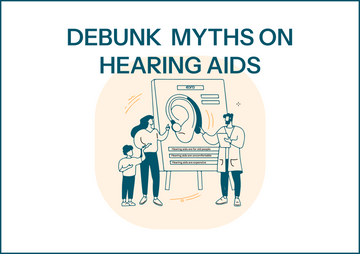In a world where sounds enrich our lives, the experience of hearing loss can be incredibly isolating. According to recent studies, approximately 48 million Americans experience some form of hearing loss. With the introduction of OTC hearing aids, the conversation around hearing health is more important than ever. Yet, many myths about hearing aids perpetuate misunderstandings and misinformation. Let's set the record straight and explore the truth behind these common myths.
Myth 1: Hearing Aids Are Just for the Elderly
Many people assume that hearing aids are only for older adults. While it’s true that age-related hearing loss is common, individuals of various ages can experience hearing loss or tinnitus. Factors such as exposure to loud noises, specific medical conditions, and genetic predisposition can contribute to hearing difficulties at any age. Therefore, it's important to consider hearing aids as a viable option for anyone affected by hearing loss.
Young People and Hearing Loss
In recent years, we’ve seen a rise in hearing loss among younger populations, particularly due to the use of headphones and exposure to loud music. It’s crucial for everyone, regardless of age, to undergo regular hearing assessments, ideally conducted by an audiologist, to determine if a hearing aid might be necessary.
Myth 2: Hearing Aids Will Restore Hearing to Normal
One of the biggest misconceptions is that hearing aids can fully restore hearing. While OTC hearing aids and prescription options significantly amplify sound, they cannot replicate normal hearing. Hearing aids are designed to assist individuals with hearing loss by enhancing sounds and making conversations easier to follow. However, the extent of their effectiveness can vary based on the user’s type and degree of hearing loss.
The Reality of Hearing Aids
For someone with mild to moderate hearing loss, hearing aids can greatly improve communication abilities. However, for those with severe hearing loss, the experience may differ. Consulting with an audiologist is essential to understand what level of benefit can be expected from each individual’s hearing aids.
Myth 3: Hearing Aids Are Uncomfortable and Bulky
We've all seen the stereotype of cumbersome hearing aids that are noticeable and uncomfortable. The truth is that technological advancements have led to sleek designs and customizable options. Most modern hearing aids are designed with comfort in mind and come in various shapes and sizes, including completely-in-canal models that are virtually invisible.
Choosing the Right Fit
When choosing a hearing aid, personal comfort is crucial. It's essential to work with an audiologist to select the style that best fits your needs and preferences. This ensures that you are not only comfortable wearing your hearing aids but also receiving the best possible auditory assistance.
Myth 4: Hearing Aids Will Make You Seem Old
Many people worry that wearing hearing aids will signal to others that they are aging or that they have a "problem." However, this stigma is slowly fading as awareness about the importance of hearing health increases, particularly with younger generations experiencing hearing loss. In fact, many individuals rock their hearing aids as stylish accessories, often opting for colorful designs or patterns.
Changing Perspectives
As society continues to promote discussions about mental health and wellness, acknowledging and treating hearing loss should be seen as just as important. Embracing hearing aids and normalizing their use contributes to a culture of acceptance and understanding around hearing health.
Myth 5: Hearing Aids Emit Unpleasant Feedback Sounds
A long-held belief about hearing aids is that they cause a constant whistling or feedback sound. While this concern was more relevant to older hearing aid models, modern devices are equipped with advanced technology that effectively mitigates feedback. Proper fitting and adjustment by an audiologist can further minimize the chances of feedback occurring.
Technology at Work
Today's hearing aids utilize digital technology that enables them to adjust sound levels according to the user's environment. If feedback does occur, it is often a sign that adjustments are needed, which can be easily addressed in follow-up audiology appointments.
Myth 6: Hearing Aids Are Too Expensive
While some high-end hearing aids can be costly, the introduction of OTC hearing aids has made assistive hearing technology more accessible than ever. Prices vary based on features and technology, but there are options available for every budget. It’s essential to remember that investing in hearing aids can improve quality of life, relationships, and overall well-being.
Financial Assistance and Insurance
Many individuals might be surprised to learn that some insurance plans offer support for hearing aids. Furthermore, government programs and charitable organizations can aid those who experience financial barriers. Exploring local resources can provide additional means of accessing hearing technology without breaking the bank.
Myth 7: You Don’t Need to See an Audiologist for Hearing Aids
A common misconception is that hearing aids can be purchased without professional guidance. While OTC hearing aids offer convenience, seeing an audiologist for a comprehensive hearing assessment is critical. An audiologist can provide professional advice tailored to individual needs and circumstances, offering peace of mind and ensuring optimal hearing health.
The Audiologist Advantage
Audiologists play a pivotal role in hearing health, from assessing the degree of hearing loss to recommending appropriate hearing aids. They also provide ongoing support, from initial fittings to adjustments, ensuring that users receive the most from their devices over time.
Myth 8: Hearing Aids Are All the Same
Another myth is that all hearing aids function similarly, but this is far from the truth. Hearing aids come with various features, styles, and technologies tailored to different needs. Some users may benefit from additional features like Bluetooth connectivity, noise cancellation, or adjustable settings that adapt to the environment.
Choosing the Right Features
When selecting a hearing aid, consider which features align best with your lifestyle. Working closely with an audiologist can help you navigate the options available, ensuring you choose the best fit based on your unique hearing needs and personal preferences.
Myth 9: Maintaining Hearing Aids Is Complicated
Many people believe that maintaining hearing aids can be a daunting task. On the contrary, caring for these devices is relatively simple! Basic maintenance involves regular cleaning and battery checks, which can easily become part of a daily routine.
Routine Maintenance Tips
- Clean the hearing aids daily with a soft, dry cloth.
- Check the battery levels frequently to ensure optimal performance.
- Avoid exposing hearing aids to moisture and extreme temperatures.
- Schedule regular check-ups with your audiologist for professional cleaning and maintenance.
Dispelling the Myths: Embracing the Reality of Hearing Aids
As we debunk these myths, the importance of being informed about hearing aids and hearing loss cannot be overstated. Hearing aids are a valuable tool for improving communication and enhancing quality of life, whether you’re dealing with age-related hearing loss, tinnitus, or hearing issues due to other factors.
It’s essential to consult with a qualified audiologist to address any concerns related to hearing aids and to make informed decisions based on individual needs. Whether you opt for an OTC hearing aid or go through the standard audiologist route, the goal is the same: to foster a more enriching auditory experience.
Remember, taking action on hearing health can lead to newfound connections with family, friends, and the world around you. Embrace the journey towards better hearing and don’t let myths hold you back from the life experiences waiting for you!

























